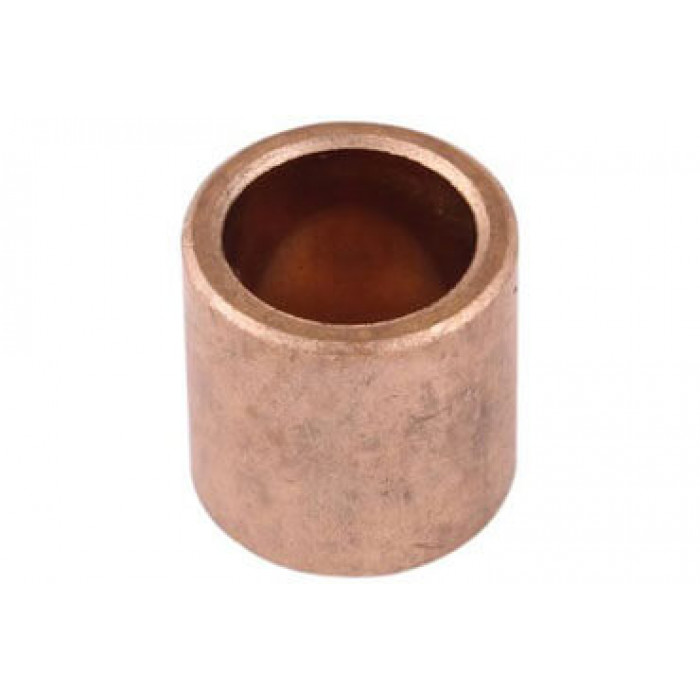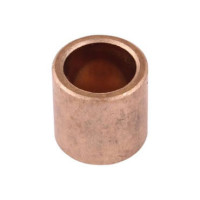The copper plug 7х11х18 mm is a color copper rolling. The cross section of the sleeve is a circle with an internal cavity. Copper bushings are used in various areas of industrial production. They are used, to increase the duration, in mechanisms that work "on friction and sliding." Bushings play the role of consumables, protecting the main operating mechanisms and assemblies from wear.
In industry, copper bushings with a diameter of 50 mm to 1000 mm are used.
The copper sleeve is used as a rotation or rolling part, resistant to corrosion.
Depending on the method of use, there are: fixing, sealing, bearing and adapter sleeves.
Copper bushings are made with a chemical composition according to GOST 859-2001. These alloys include: M1r, M0, M1f, M1, M2, M3. These alloys differ not only in chemical composition, but also in technical characteristics that determine their scope.
The method of obtaining copper bushings is stamping, casting (in a chill mold, centrifugal). Each of the above manufacturing methods involves pre-machining.
The scope of copper bushings is quite wide. These parts are used in various devices (measuring, medical, electronic); as parts of cars, airplanes, computers, spaceships and so on.
To clarify a little, copper bushings are part of plain bearings that operate under high pressure. Bushings are also used in friction units of mechanisms, pumps operating in sea water, pressure and spindle nuts. In addition, they are part of the nodes of mechanisms that are constantly exposed to steam, water or fuel in a liquid state.
The copper bushing is a non-ferrous rolled copper. The cross section of the sleeve is a circle with an internal cavity. Copper bushings are used in various areas of industrial production. They are used, to increase the duration, in mechanisms that work "on friction and sliding." Bushings play the role of consumables, protecting the main operating mechanisms and assemblies from wear.
In industry, copper bushings with a diameter of 50 mm to 1000 mm are used.
The copper sleeve is used as a rotation or rolling part, resistant to corrosion.
Depending on the method of use, there are: fixing, sealing, bearing and adapter sleeves.
The positive properties of copper bushings, as parts of mechanisms and assemblies, are:
- resistance to attrition;
- anti-corrosion resistance;
- possibility of operation in a wide temperature range;
- strength and durability;
- relative cheapness;
- high resistance to humidity.
Production
Copper bushings are made with a chemical composition according to GOST 859-2001. These alloys include: M1r, M0, M1f, M1, M2, M3. These alloys differ not only in chemical composition, but also in technical characteristics that determine their scope.
The method of obtaining copper bushings is stamping, casting (in a chill mold, centrifugal). Each of the above manufacturing methods involves pre-machining.
The most common method of manufacturing bushings is centrifugal casting. This method allows the production of high quality products with improved mechanical properties and high density. In addition, such bushings have a low cost.
The method of centrifugal casting of bushings is based on the fact that the filling of the mold with a copper alloy and the subsequent hardening of the product takes place under the influence of centrifugal forces, which significantly exceed the force of gravity.
During the technological process, solid metal particles, touching the walls of the mold, are pressed against it and no longer float up. The centrifugal casting method is one of the most common casting methods. Most often, the method is used for the manufacture of hollow castings. First, a mold is filled with molten copper alloy, which rotates, and then centrifugal force is applied to it. The production process of centrifugal casting is realized on centrifugal casting machines. The shape of the sleeve produces rotation about an inclined axis, horizontal or vertical.
Most often, the horizontal rotation method is used for the production of bushings. In this case, the outer surface of the sleeve is formed on the inner surface of the mold, and the inner under the action of centrifugal forces.
Hot copper alloy is poured into a mold, which rotates continuously, through a special chute. The metal spreads over the mold and, under the influence of centrifugal forces, is formed into a sleeve with an internal cavity. Then the metal is allowed to harden and the sleeve is removed from the mold. Such a technological process is characterized by a high yield coefficient, almost 100%.
If bushings are made with a free surface in the form of a parabola, then the mold is moved relative to the vertical axis. In this case, the manufacturing process of the sleeve is carried out under the action of centrifugal, as well asgravitational forces.
Copper bushings, formed by centrifugal casting, are distinguished by:
- high density;
- absence of shells in metal;
- the absence of foreign inclusions in the metal of the bushing.
According to the agreement with the customer, bushings can be manufactured according to special requirements. Namely, with the inclusion of additional operations in the technological process: heat treatment, machining, milling, grinding, drilling holes, threading, surface coating.
nevertheless, copper bushings are marked by the name of the alloy, and not by the base metal that is part of it - that is, as bronze. For the manufacture of bushings, such brands of bronze as BrO4Ts4S17, BrO5Ts5S5, BrO10F1, BrO8S12 and others permitted by Russian standards are used. The shapes and sizes of the bushings can be any.
The use of bushings makes it possible to extend the service life of the most important parts of the mechanisms, which ultimately reduces the risk of accidents, increases the reliability of their operation and service life. In its own way, a copper bushing - or bronze, as you prefer - allows the company to work more efficiently and save on the repair of equipment or its purchase.
Disadvantages of copper bushings
While copper bushings have many advantages, there are some potential disadvantages as well. The cost of copper can be expensive compared to other materials such as PVC or PEX. In addition, proper installation requires special tools and skills; otherwise, you may end up with leaking or blocked bushings. In addition, exposure to some of the chemicals found in household cleaners, if used improperly, can cause pitting on bushings over time.
Causes of corrosion
When exposed to air, moisture, or certain chemicals found in cleaning products (such as ammonia), the surface of copper bushings can oxidize, known as corrosion, and weaken over time. This corrosion causes pinpoint leaks that can damage plumbing if not dealt with. To prevent this from happening, make sure you are using the proper copper bushing cleaners and inspect them periodically for signs of corrosion or mineral buildup that could lead to clogging.
The scope of copper bushings is quite wide. These parts are used in various devices (measuring, medical, electronic); as parts of cars, airplanes, computers, spaceships and so on.
To clarify a little, copper bushings are part of plain bearings that operate under high pressure. Bushings are also used in friction units of mechanisms, pumps operating in sea water, pressure and spindle nuts. In addition, they are part of the nodes of mechanisms that are constantly exposed to steam, water or fuel in a liquid state.
You can buy the Copper bushing 7х11х18 mm from us at the most favorable price in Ukraine. A wide range of products allows us to quickly and efficiently fulfill any order, helping to complete any construction work on time.
No questions about this product, be the first and ask your question.


